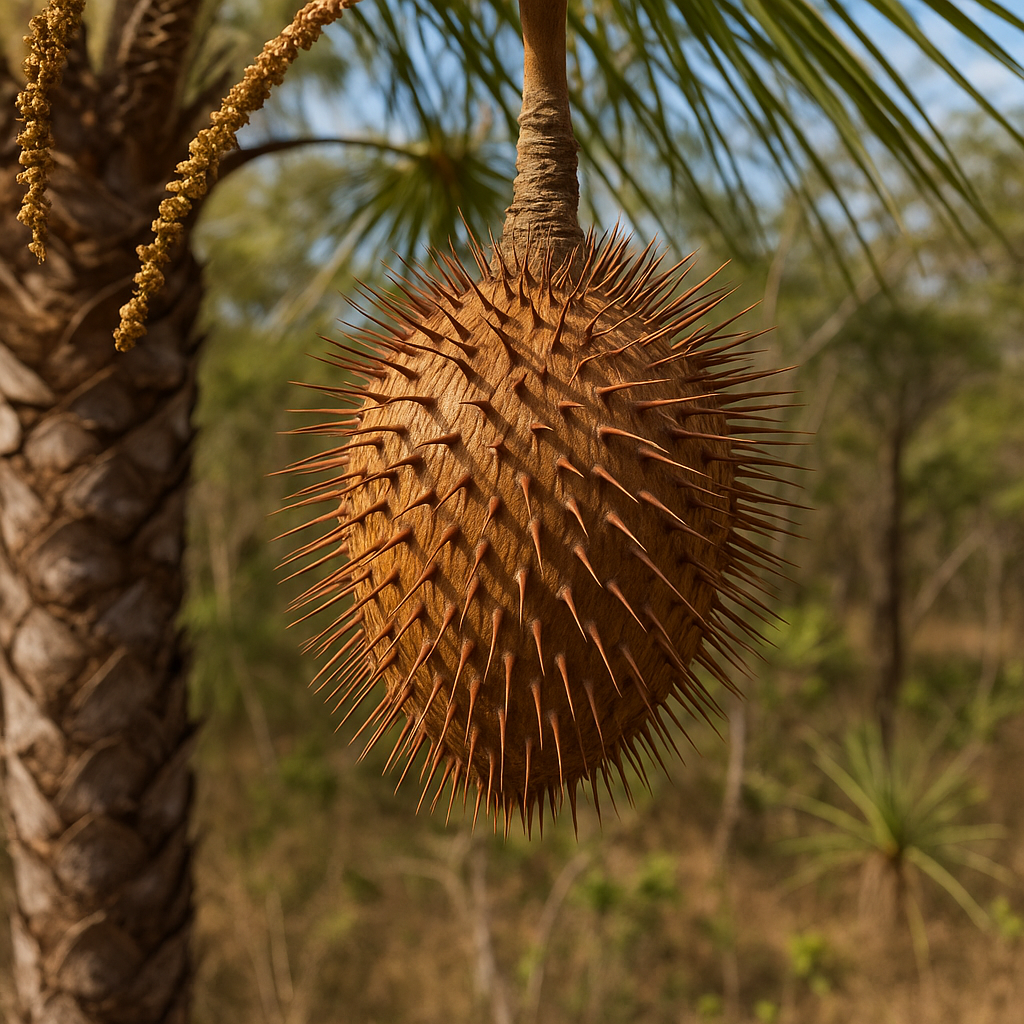The spiny coconut, commonly known in Brazil as ouricuri or Syagrus coronata, is a native palm tree that thrives in the harsh conditions of the Brazilian Caatinga. Though less famous than the typical coconut palm (Cocos nucifera), this species holds incredible ecological, cultural, and economic value for rural communities and environmental projects.
Botanical Characteristics
The spiny coconut is a medium-sized palm that can grow up to 10 meters tall. Its trunk is covered with the remains of old leaves that turn into long, sharp spines—hence its popular name. The fronds are long and feathery, often reaching lengths of up to 3 meters, and the plant displays an elegant but rugged appearance.
Its yellowish flowers are small and grouped in clusters, while the fruits are oval, ranging from 5 to 8 cm, with a hard outer shell and a fibrous interior. The fruit’s skin turns golden brown when ripe, and it’s covered with stiff spines that make handling a challenge without protective gear.
Where It Grows
This palm is native to Brazil and is primarily found in the northeastern states such as Bahia, Pernambuco, Sergipe, Paraíba, Alagoas, and Rio Grande do Norte. It thrives in arid, rocky soils and demonstrates exceptional drought resistance, making it ideal for reforestation and land recovery in degraded areas.
The spiny coconut is particularly suited to agroforestry systems and plays a key role in preserving biodiversity within the Caatinga biome.
Traditional and Economic Uses
Despite its intimidating appearance, the spiny coconut is an extremely versatile plant with several traditional and commercial applications:
1. Food Source
The pulp of the fruit is edible and slightly sweet, rich in oils. Local communities extract a natural oil from the pulp, similar to coconut oil but with a stronger flavor. This oil is used in cooking and sometimes for cosmetic purposes.
The inner flesh can also be dried and ground into flour, used in traditional recipes such as cakes and porridges.
2. Handicrafts
The leaves and fibers of the ouricuri palm are widely used in traditional crafts. Artisans transform them into hats, mats, baskets, bags, and decorative items. These handmade goods are important sources of income for rural families, especially women in community cooperatives.
The fibers are strong yet flexible, and harvesting them sustainably does not harm the tree.
3. Medicinal Uses
In folk medicine, the leaves are boiled into teas to relieve inflammation, respiratory issues, and intestinal discomfort. The extracted oil is applied topically to treat dry skin, wounds, and rashes.
Although scientific studies are limited, the plant’s healing reputation has been passed down for generations in local traditions.
Environmental Importance
The spiny coconut is more than just a practical plant—it plays a vital ecological role in the Caatinga biome:
- Its flowers attract bees and other pollinators.
- The fruits feed wild animals, including birds, monkeys, and small mammals.
- Its deep root system helps stabilize soil, preventing erosion and retaining water in arid regions.
Because it grows naturally in poor soil and resists fire and drought, the ouricuri palm is a valuable ally in climate adaptation and land regeneration strategies.
Fun Facts
- The word ouricuri originates from the Tupi language, meaning “spiny”.
- Some artisans use the seeds to carve buttons and beads, thanks to their hardness and smooth texture.
- Though hard to process due to its spines, traditional tools and skills passed down in rural communities make harvesting manageable.
- The palm is a symbol of resilience in the semi-arid regions of Brazil.
Sustainability and Conservation
Despite its many benefits, the spiny coconut faces threats from deforestation, overharvesting, and habitat degradation. Conservation efforts are underway to protect this species by promoting:
- Sustainable extraction techniques;
- Environmental education;
- Agroecology and biodiversity programs.
Supporting the use of native plants like the ouricuri helps preserve local ecosystems while also strengthening traditional knowledge and rural economies.
Final Thoughts
The spiny coconut may be lesser known, but it’s a treasure of Brazil’s northeast. With its edible pulp, durable fibers, medicinal potential, and ecological resilience, this palm is a testament to the strength and diversity of native flora. Embracing and conserving the ouricuri is a step toward a more sustainable, culturally rich, and ecologically balanced future.

Revitalize your skin with the power of coffee and coconut!
Try the OGX Coconut Coffee Scrub and feel your skin softer, smoother, and more hydrated from the very first use.
👉 Buy now and turn your shower into a tropical spa experience!
Carqueja – Benefits & Uses of This Powerful Medicinal Plant
Discover the health benefits and traditional uses of Carqueja, a plant valued for its digestive, liver, and overall wellness properties.
Read More
